Japan–China Private-Sector Exchanges to ResumeJapan–China Field Officer Exchange to restart after 4 years
Japan–China Sasakawa Medical Fellowship to mark 35th anniversary after 1-year postponement
A press conference was held at The Nippon Foundation’s head office in Tokyo on May 30 to announce the resumption of two private-sector exchange programs between Japan and China. This year marks the 45th anniversary of the signing of the Treaty of Peace and Friendship between Japan and China, and in July the Japan–China Field Officer Exchange program for officers of the Japan Self Defense Forces and the People’s Liberation Army, which had been suspended for four years because of the coronavirus pandemic, is scheduled to resume. In addition, a ceremony to mark the 35th anniversary of the Japan–China Sasakawa Medical Fellowship, which was postponed from last year because of the pandemic, is scheduled to take place on July 28. A memorandum of understanding extending the Field Officer Exchange program for an additional 10 years is scheduled to be signed in the near future, with The Nippon Foundation Chairman Yohei Sasakawa calling the program “very significant in light of increasingly challenging Japan-China relations.”

Speakers’ Comments
Yohei Sasakawa, Honorary Chair, Sasakawa Peace Foundation (Chairman, The Nippon Foundation)
I am not promoting private-sector exchange to develop people who are fond of Japan, but rather to cultivate people who are knowledgeable about Japan, so that they can make Japan better. This is especially true for the Japan–China Field Officer Exchange program, which is why I have visited China as Honorary Chair of the Sasakawa Peace Foundation and met with members of China’s defense ministry to exchange opinions and confirm our intention to extend the program for an additional 10 years. The Sasakawa Peace Foundation intends to sign a memorandum of understanding for the extension in the near future. Given the turbulent international situation in general, relations between Japan and China are likely to become more challenging, and I consider the signing of this extension, based on an assumption of friendly relations for the long time period of 10 years, to be extremely significant. The Japan–China Sasakawa Medical Fellowship program was launched in 1986, when students in China were unable to study abroad or if they did study abroad, would sometimes not return to China. Nevertheless, the program has seen 100 medical students visit Japan every year, and all of them are now working in China. As a result, this program is highly recognized by the Chinese government.

Atsushi Sunami, President, Sasakawa Peace Foundation
Recognizing our mission as a private-sector foundation and the important role we play, we restarted the Field Officer Exchange program in 2018 to ensure private-sector exchange in accordance with our mission of promoting mutual understanding. Private-sector exchanges need to continue. This is why I believe our private-sector mission is to create opportunities for building mutual understanding and trust. This resumption was not initiated by the Sasakawa Peace Foundation on its own; the Chinese side, with which we have had relations for many years, said that they would like to work with the Sasakawa Peace Foundation. I believe this shows that the Chinese side also considers private-sector exchanges to be important.

Hideoki Ogawa, President, Japan China Medical Association
Over the 37 years since the establishment of the Japan–China Sasakawa Medical Fellowship program, there has been a significant increase in the number of graduates who are now researchers or research directors at national-level scientific institutes. Of the 1,250 scholarship recipients, 18 have become university or medical school presidents and vice presidents, and 30 are hospital directors or assistant directors. Today, the relationship between Japan and China is shifting from an age of “research direction” to an age of “joint research,” and we aim for this program to be a model for joint research between Japan and China.

Contact
Public Relations Team
The Nippon Foundation
- Email: cc@ps.nippon-foundation.or.jp



